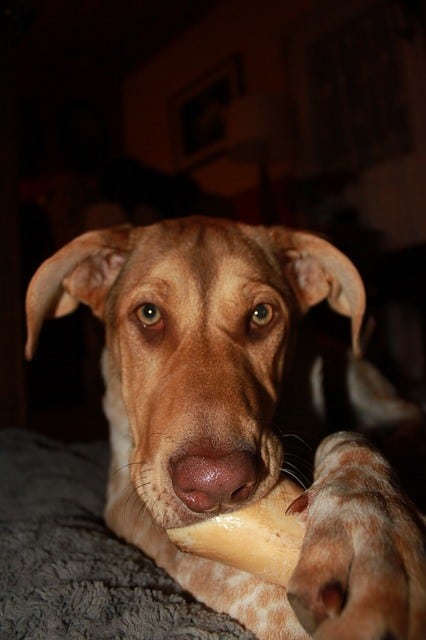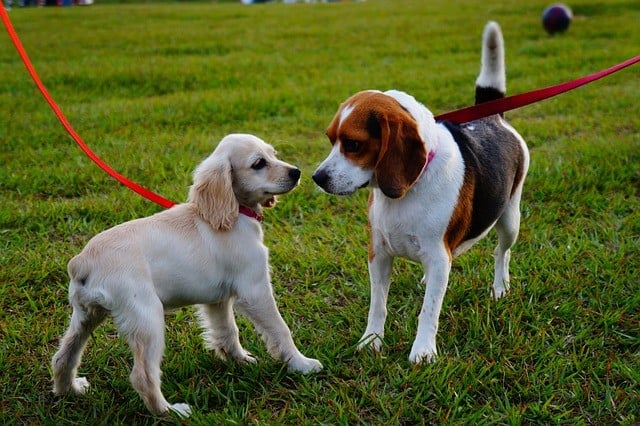
It used to be that every time you left the house, you had to leave Fido behind no matter where you were going. These days, there are all kinds of dog-friendly businesses that will welcome him, but it can become a question of whether he should tag along. If your pup is a little rough on his public etiquette skills, it’s a good idea to work on building them at home.
This guide will demonstrate the ways you can use your own home to help your dog perfect his public etiquette skills, whether you want to visit a park, restaurant or bar where dogs are permitted. Keep in mind that some dogs may need more time to make the transition from practicing at home to venturing out into public, especially if they have trouble socializing in general. For dogs with severe social anxiety or aggression issues, seek additional guidance from a qualified trainer or behavioral specialist.
(NOTE: In addition to his refined manners, always make sure your canine companion is up-to-date on all necessary shots, vaccines and pest treatments before bringing him into a public space.)
Start With the Basics
Part of what makes going out in public with your dog so tricky is that you aren’t completely in control of his environment. There are all kinds of foreign sights, smells and people that will immediately surround him, not to mention the endless sounds he’ll be hearing. It can be overwhelming, and it’s not something you can rush your dog into if he’s spent most of his time at home.
Basic leash training and crate training are great places to start. Some dogs see most of their leash time on walks around the neighborhood or trips to the vet and may not spend much time on their leash indoors, so make sure yours understands that the same rules apply no matter the setting: he should walk at a distance that leaves a little bit of slack on the leash, match his pace to yours, and never pull or attempt to drag you in any direction. This kind of obedience is particularly important when you’re navigating through a maze of tables at a café or between crowds of people at a bar. A crate training schedule can help create a well-mannered puppy so you can bring them wherever you go.
Practice walking with him through the house on his leash, possibly even rearranging some furniture to create the general layout of a café or restaurant. Lead your pup through specific pathways, making sure he follows closely behind or next to you and doesn’t pull or veer off. Make a few sudden stops, change directions, and allow for some distractions; perhaps your partner could sit on the couch while you lead your dog past without stopping. Try it with music on and in different kinds of lighting.

Image via Pixabay
If you have a large family — or even just a few friends or neighbors over — try working with your dog on how he handles crowds. It won’t be an exact comparison to being in a public setting since he’ll be familiar with everyone there, but it can be a good opportunity to practice weaving through people in a crowded space. He should understand (and demonstrate) that no matter where he is or who else he sees, he is always to follow and obey whoever is guiding him on the leash.
Next, start fine-tuning your dog’s basic obedience skills. Sit, stay, come, and down are all going to be the most important commands when you’re in public together, so make those your priority. Additionally, see how Fido does with being tethered to you. Should you go to a dog-friendly restaurant or café, you’ll want to be sure he won’t feel panicked while restrained or try to flee if something startles him. Nothing ruins a meal like being dragged across the room mid-bite!
If your pup isn’t great with obedience skills to begin with, make sure you train in a quiet, distraction-free area. As he gets to be more consistent — not only in his training sessions but also in his daily routine — start making your training more challenging:
- Play music in the background
- Have other people walk in, then stay in the room
- Ask a friend or family member to create loud (but not frightening) noises
- Have food nearby
- Move your lessons outside
You won’t be able to replicate every possible scenario you and your dog will encounter on your outings together, but you can help him learn to focus despite distractions.
Public Dining Etiquette
Building strong table manners in your pet is important both at home and in public. After all, no one likes to deal with a dog begging for scraps while they’re eating, especially at a restaurant! Preparing Fido to be a polite dining companion might require you to change up your everyday mealtime routine if he’s usually not allowed near the table; as you start to make the shift, talk to your family or roommates about the new plan and make sure everyone is committed to enforcing the new rules.
There are a few main skills you’ll want to focus on when it comes to dining etiquette. Your dog should:
- Be comfortable sitting or lying somewhere close by, but clear of walking paths;
- Never beg for food;
- Limit sniffing around the floor, table, and chairs for scraps.
Start by leashing your dog (this may also act as a cue to him that mealtime rules will be different — leash off means he must stay in the other room while you eat, leash on means he must sit in a designated spot quietly, for example) and walking him calmly to the table. Pick a spot for him to sit or lie down that will be out of the usual walking paths. If Fido tends to be somewhat territorial, it might help to have family or roommates walk past him throughout the meal. If he barks, growls, or is otherwise aggressive as people pass, scold and correct this behavior. Alternatively if he’s calm and collected as someone walks by, be sure to praise him for his composure.
Some owners like to bring a nice chew bone or other treat that will keep their dog occupied while they dine. Bear in mind that this might not be the best option for dogs with possessive tendencies, especially if there will be other dogs around that he might think will try to steal his toy. Choose something that is quiet (or at the very least doesn’t squeak) and avoid toys that your dog will immediately destroy. Be prepared to clean up any debris he leaves behind; your home training sessions will give you a good idea of what will be too messy to bring in public. Chew bones are often an ideal choice since they aren’t messy and don’t make much noise. However, if your dog tends to be a loud chewer, it could be incredibly disruptive in a quieter café setting. Additionally you should only choose toys that won’t hurt his belly. Long-lasting chew sticks might be his favorite treat and probably won’t be a problem while you’re polishing his etiquette at home, but the anxiety of being in public might cause your dog to get a bit overzealous in devouring the stick and could even cause stomach issues.

Image via Pixabay
Even if he’s got a bone to keep him occupied, your pup might be tempted to beg for food when he sees it. Correct this behavior immediately as you train him, and never feed him scraps directly from your table. No matter how sad and hungry he looks, it’s important to remind yourself that you are a loving pet owner who feeds their dog well. Plus, if you give in even just once, you’ll reinforce the idea that begging for food actually works; it’s confusing for dogs to get out of this mindset once they’ve been appeased. Once you make the switch to a public setting, he’ll probably be getting plenty of extra attention anyway (and some establishments even offer dog-friendly options on their menus), so don’t let him lose sight of the rules just because you’re not at home.
Park Etiquette
Whether it’s so you can visit the park down the street or a local dog park, there are plenty of ways to prepare your dog from the comfort of your own yard. Outdoor leash training is a must, especially if your dog is prone to pulling. Lead him through the backyard on his leash. Walk at a leisurely pace, then more quickly. Practice making sudden stops, and have him heel and sit at your side. The two of you should be able to walk cohesively together no matter the speed, time of day, or exact location in your yard.
Off-leash dog parks are wonderful for Fido, but can be more difficult to train for. You’ll need to be sure your pooch always comes when called, so practice in the backyard. Call him over periodically while he’s playing, and reward him each time he obeys. If you have a particularly large yard, be vigilant about keeping him in your sight and call him back if he wanders too far. Even if you won’t be doing any leash training that day, practice calling him over with his leash in your hands. If he isn’t a fan of being restrained, he might be less inclined to obey a “Come” command if he sees the leash. The better he gets at obeying you at home, the more easily his skills will translate to a public setting.

Image via Pixabay
You may also want to help your dog get used to various weather conditions that are common in your area. If, for example, you live in a region that sees a lot of rain, you’ll want to be prepared for his reaction should you get caught in a sudden thunderstorm or have to dash to the car in the rain after dinner on the town. You don’t necessarily have to drag him out into the rain every time it storms, but do make a point of getting him out in various conditions when it’s safe to do so. If he has any necessary gear — a rain poncho, boots, or a sweater, for instance — let him practice wearing it in the backyard when possible. The more comfortable he feels wearing the gear at home, the better he’ll do while you’re out in public.
Trips to the park will inevitably mean socializing with other dogs. Try inviting your friends and neighbors over with their own pups — throwing a dog-friendly barbecue can be the perfect opportunity — but don’t overwhelm him with canine company if he’s not used to it. Seeing another dog in his yard (in his territory) can make Fido feel anxious even if he’s typically friendly, so start with a single play date and work your way up to groups. Practice your leash training and obedience skills while other dogs and people are present in the yard; remember, he needs to be able to focus on obeying you despite any distractions.
If your dog isn’t used to going out in public with you, start with low-pressure settings like a quiet café or small park at non-peak hours. Keep up with consistent training at home, and ease him into busier locations as his skills get stronger. If you see him regress into poor manners, refine the specific skills he’s lacking and consider making this training a regular part of your home routine. In time, he’ll know exactly what to do no matter where you go. He might even have the best public etiquette skills of any dog in your neighborhood!

 United States
United States Canada
Canada